Historic Nottingham - Part 9 - Castle Gate (East)
w/e 13 January 2008
All this week's pictures were taken
with a Kodak DX6490
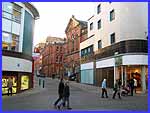 Resuming
our walk through some of the streets of Historic Nottingham,
we are about to enter Castle Gate as we head back towards the
castle. Our objective will be met in the next and final part
of the series that is following the route as described in Malcolm
Sales' book "100 Walks In Nottinghamshire". We will
see the western end of Castle Walk in the next part but all of
the photos in both Parts 9 and 10 were taken on the same day.
Unfortunately that day was a wet one and I had to dodge from
one side of the street to the other to seek shelter and to try
and keep the rain off the lens. Apologies in advance if any raindrops
show up. Resuming
our walk through some of the streets of Historic Nottingham,
we are about to enter Castle Gate as we head back towards the
castle. Our objective will be met in the next and final part
of the series that is following the route as described in Malcolm
Sales' book "100 Walks In Nottinghamshire". We will
see the western end of Castle Walk in the next part but all of
the photos in both Parts 9 and 10 were taken on the same day.
Unfortunately that day was a wet one and I had to dodge from
one side of the street to the other to seek shelter and to try
and keep the rain off the lens. Apologies in advance if any raindrops
show up.

 Since
our last visit, Christmas has come and gone, the trees seen in
this view back to Low Pavement have lost their leaves and the
inclement weather meant that there were far fewer shoppers about.
Whether any of those shoppers noticed the sign over the door
of Weavers' shop in Castle Gate, I'm not sure but it reads as
follows: "Site of the family business of Geoffrey Trease,
an innovative children's author who made history come alive (1909-1998)".
Trease's family were wine merchants but after an education at
Nottingham High School and Oxford University, Geoffrey went on
to publish 113 books, many of which were translated for foreign
markets. Since
our last visit, Christmas has come and gone, the trees seen in
this view back to Low Pavement have lost their leaves and the
inclement weather meant that there were far fewer shoppers about.
Whether any of those shoppers noticed the sign over the door
of Weavers' shop in Castle Gate, I'm not sure but it reads as
follows: "Site of the family business of Geoffrey Trease,
an innovative children's author who made history come alive (1909-1998)".
Trease's family were wine merchants but after an education at
Nottingham High School and Oxford University, Geoffrey went on
to publish 113 books, many of which were translated for foreign
markets.
|
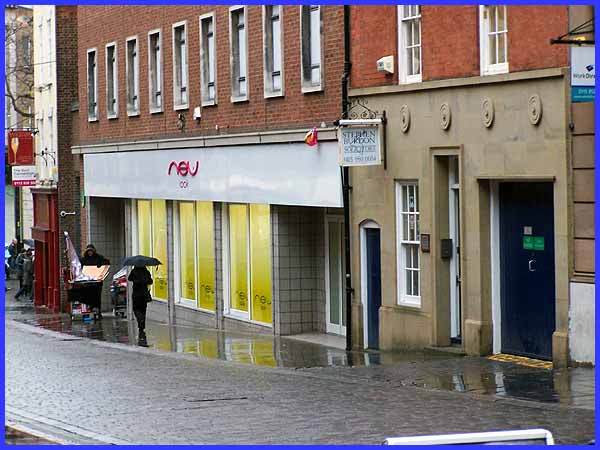
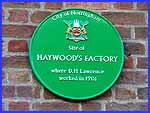 Geoffrey
Trease is well known for his children's historical novels but
a few years before he was born another Nottinghamshire author
famed for literature of a more mature nature, worked in the factory
next door. A green plaque shows that D. H. Lawrence was employed
as a junior clerk in Haywood's Surgical Goods factory which stood
on the site in 1901. An information board in Castle Gate also
records this fact adding that it was his first job and that the
site is now occupied by W. H. Smith's. Smith's have since moved
out, the building now being occupied by New Look. D. H. L. (1885-1930)
described his time at the factory in "Sons and Lovers". Geoffrey
Trease is well known for his children's historical novels but
a few years before he was born another Nottinghamshire author
famed for literature of a more mature nature, worked in the factory
next door. A green plaque shows that D. H. Lawrence was employed
as a junior clerk in Haywood's Surgical Goods factory which stood
on the site in 1901. An information board in Castle Gate also
records this fact adding that it was his first job and that the
site is now occupied by W. H. Smith's. Smith's have since moved
out, the building now being occupied by New Look. D. H. L. (1885-1930)
described his time at the factory in "Sons and Lovers".
|
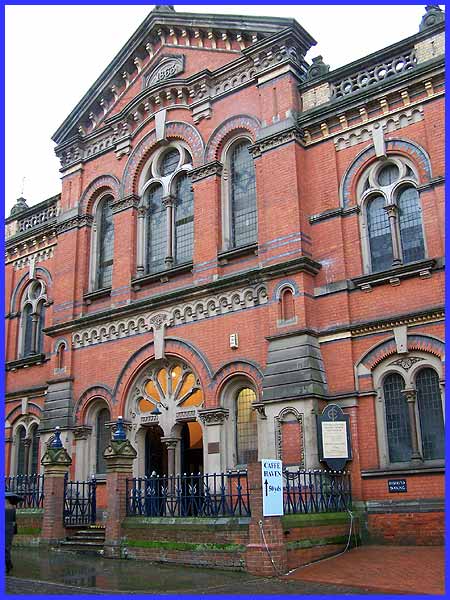
 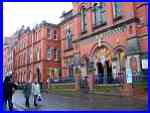 On the
opposite side of the road stands the Congregational Centre which
dates from 1863 although this was built on the site of the first
non-conformist church in the city that opened in 1689. The same
information board mentioned above also states that Nottingham
has a long, honourable tradition of religious dissent. Part of
the Centre now houses a Christian Book Shop and the information
board makes mention of the fine and detailed brickwork on the
façade of the building. On the
opposite side of the road stands the Congregational Centre which
dates from 1863 although this was built on the site of the first
non-conformist church in the city that opened in 1689. The same
information board mentioned above also states that Nottingham
has a long, honourable tradition of religious dissent. Part of
the Centre now houses a Christian Book Shop and the information
board makes mention of the fine and detailed brickwork on the
façade of the building.
|
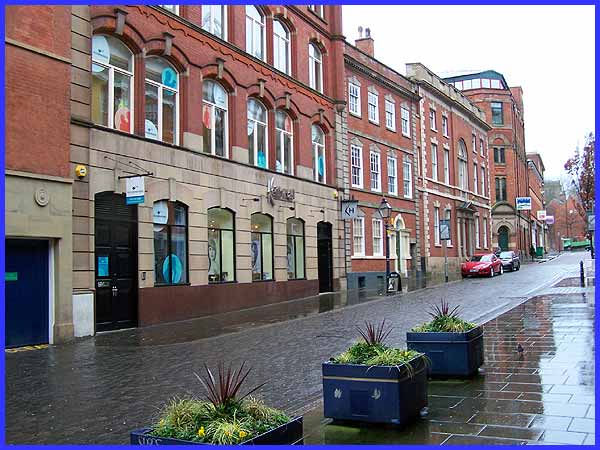
Back on the other side of the road are some more old buildings.
The one to the right of centre was built about 1750 with the
one further right with the red car outside is from 25 years later.
This is 19 Castle Gate and it was built by William Stanford who
is also recorded in history as having donated half a hogshead
of ale to assist in the celebrations in 1789 when King George
III regained his sanity.
|
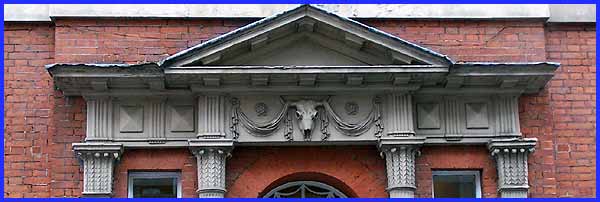
Many of these old buildings are finely embellished and the decoration
above the doorway of 19 includes an ox-skull and drapery representing
Greek and Roman pagan altars.
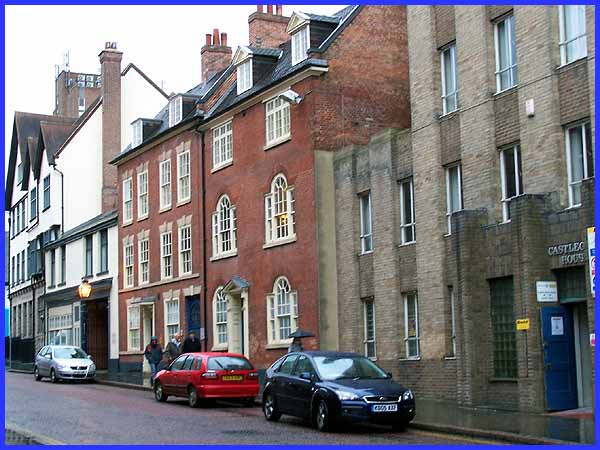
Switching back once more to the north side of Castle Gate and
a variety of architectural styles come into play but the two
brick built properties in this picture both date from the eighteenth
century.
|
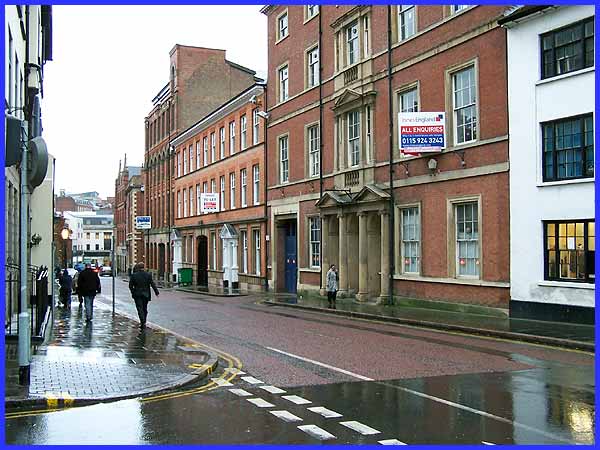
We have now reached roughly the half way point of our walk along
Castle Gate and a glance back will reveal more eighteenth century
constructions on the south side of the road. In general this
view will have changed little over the years but the view to
the west which we shall be seeing in Part 10 will reveal some
significant differences. A well-intentioned but unsympathetic
twentieth century civil engineering project cut a swathe through
the city to create the dual carriageway of Maid Marian Way bisecting
Castle Gate in the process. A picture from the 1950s (link) showing the street before the construction
work is 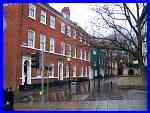 available
on the Picture
The Past website where there are also many more images of
the area. available
on the Picture
The Past website where there are also many more images of
the area.
Most of these old buildings shown in this, the next and preceding
parts are now protected as listed buildings and again, relevant
searches at the Images of England site will reveal not only
further pictures of them but many architectural details too.
For example, here is the link for 29 and 31 Castle Gate pictured above.
In the concluding part however we will continue along Castle
Gate (right) on both sides of Maid Marian Way and finish back
at Nottingham Castle.
|

